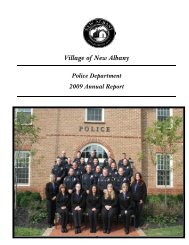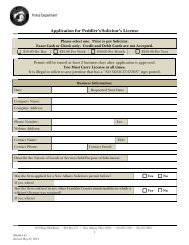NEW ALBANY POLICE DEPARTMENT - New Albany, Ohio
NEW ALBANY POLICE DEPARTMENT - New Albany, Ohio
NEW ALBANY POLICE DEPARTMENT - New Albany, Ohio
You also want an ePaper? Increase the reach of your titles
YUMPU automatically turns print PDFs into web optimized ePapers that Google loves.
<strong>NEW</strong> <strong>ALBANY</strong> <strong>POLICE</strong> <strong>DEPARTMENT</strong><br />
Directive 3.3 – Special Transport Situations<br />
3.3.1 Opposite Sex<br />
If practical, a prisoner will be transported by an officer of the same sex. For example, if a male<br />
<strong>New</strong> <strong>Albany</strong> Police Officer arrests a female, he may request an on duty, female <strong>New</strong> <strong>Albany</strong><br />
Police Officer to transport the prisoner. When beginning a transport of an individual of the<br />
opposite sex, the officer will advise the dispatcher of his/her location, final destination, and<br />
starting mileage. Upon arrival at the destination, the officer will advise the dispatcher of his/her<br />
arrival and the ending mileage. This information will be documented by the dispatcher in the CAD<br />
(Computer-Aided Dispatch) system.<br />
3.3.2 Sick, Injured, Disabled<br />
The transportation of sick, injured, and disabled individuals may require special arrangements.<br />
Necessary precautions shall be taken to ensure the safety of both the officer(s) and the<br />
prisoner(s). In those special circumstances when an individual can not be transported by normal<br />
means, the following procedures shall apply:<br />
A. The dispatcher shall be contacted and will dispatch the appropriate emergency medical<br />
services (EMS) anytime that a prisoner is, or claims to be, sick or injured. If a prisoner is<br />
to be transported to a medical facility by a medic, an officer will either accompany the<br />
prisoner in the back of the vehicle or follow directly behind the medic to the medical<br />
facility.<br />
If a prisoner is treated at the scene or refuses medical assistance and will not be<br />
transported by a medic, he/she will be transported in the normal manner. In such cases,<br />
a copy of the EMS report will be obtained by the transporting officer and included in the<br />
officer’s arrest report.<br />
The on duty supervisor shall be notified immediately by the arresting/transporting officer<br />
in any of the above-listed situations and is responsible for photographing the allegedinjury<br />
(ies), if applicable.<br />
B. In cases of non-ambulatory prisoners (those requiring wheelchairs, crutches, or<br />
prosthetic appliances), a transport van should be utilized. The transport van will need to<br />
be requested from another jurisdiction such as Columbus Police Department or the<br />
Franklin County Sheriff’s Office. Those individuals who are disabled but are ambulatory<br />
will be transported in the normal manner.<br />
3.3.3 Hospital Security and Control<br />
When a prisoner is transported to a local medical facility/hospital, the following procedures shall<br />
apply:<br />
A. Prisoners who are misdemeanor or traffic offenders shall be issued a summons/citation(s)<br />
and ordered into court at a later date. If the prisoner is in custody on a warrant for a<br />
misdemeanor offense (other than one of violence), a summons may be issued in lieu of<br />
the warrant. If the prisoner is in custody on a non-violent felony charge(s), he/she may be<br />
released on a summons only upon the approval of the Prosecutor’s office. After issuing<br />
the summons/citation(s), the officer shall notify the medical facility’s security department, if<br />
applicable, and advise them of the circumstances before departing.<br />
10















